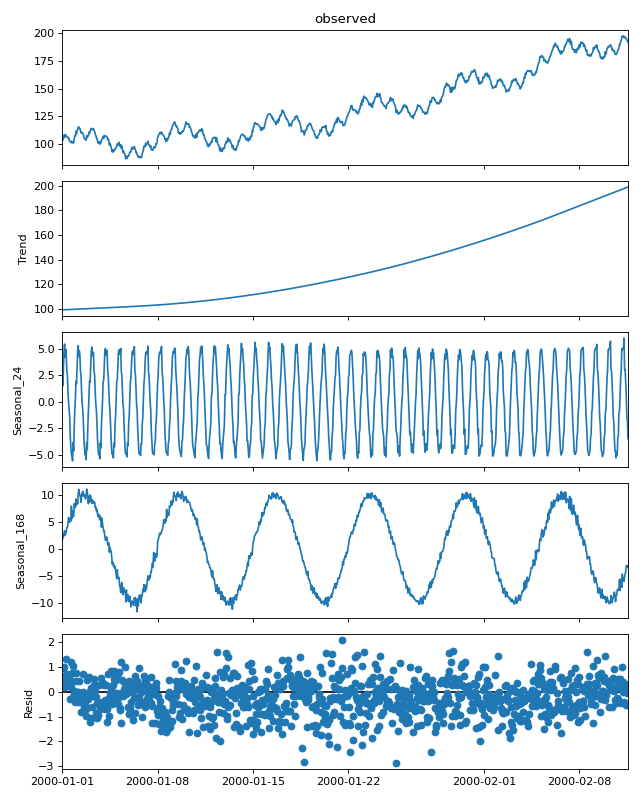statsmodels.tsa.seasonal.MSTL¶
-
class statsmodels.tsa.seasonal.MSTL(endog, periods=
None, windows=None, lmbda=None, iterate=2, stl_kwargs=None)[source]¶ Season-Trend decomposition using LOESS for multiple seasonalities.
Added in version 0.14.0.
- Parameters:¶
- endogarray_like
Data to be decomposed. Must be squeezable to 1-d.
- periods{
int, array_like,None},optional Periodicity of the seasonal components. If None and endog is a pandas Series or DataFrame, attempts to determine from endog. If endog is a ndarray, periods must be provided.
- windows{
int, array_like,None},optional Length of the seasonal smoothers for each corresponding period. Must be an odd integer, and should normally be >= 7 (default). If None then default values determined using 7 + 4 * np.arange(1, n + 1, 1) where n is number of seasonal components.
- lmbda{
float,str,None},optional The lambda parameter for the Box-Cox transform to be applied to endog prior to decomposition. If None, no transform is applied. If “auto”, a value will be estimated that maximizes the log-likelihood function.
- iterate
int,optional Number of iterations to use to refine the seasonal component.
- stl_kwargs: dict, optional
Arguments to pass to STL.
See also
References
[1]K. Bandura, R.J. Hyndman, and C. Bergmeir (2021) MSTL: A Seasonal-Trend Decomposition Algorithm for Time Series with Multiple Seasonal Patterns. arXiv preprint arXiv:2107.13462.
Examples
Start by creating a toy dataset with hourly frequency and multiple seasonal components.
>>> import numpy as np >>> import matplotlib.pyplot as plt >>> import pandas as pd >>> pd.plotting.register_matplotlib_converters() >>> np.random.seed(0) >>> t = np.arange(1, 1000) >>> trend = 0.0001 * t ** 2 + 100 >>> daily_seasonality = 5 * np.sin(2 * np.pi * t / 24) >>> weekly_seasonality = 10 * np.sin(2 * np.pi * t / (24 * 7)) >>> noise = np.random.randn(len(t)) >>> y = trend + daily_seasonality + weekly_seasonality + noise >>> index = pd.date_range(start='2000-01-01', periods=len(t), freq='h') >>> data = pd.DataFrame(data=y, index=index)Use MSTL to decompose the time series into two seasonal components with periods 24 (daily seasonality) and 24*7 (weekly seasonality).
>>> from statsmodels.tsa.seasonal import MSTL >>> res = MSTL(data, periods=(24, 24*7)).fit() >>> res.plot() >>> plt.tight_layout() >>> plt.show()(
Source code,png,hires.png,pdf)
Methods
fit()Estimate a trend component, multiple seasonal components, and a residual component.